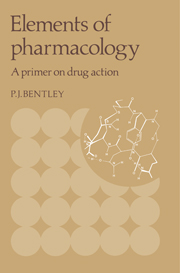Book contents
- Frontmatter
- Contents
- Preface
- 1 Introduction
- 2 Scope of pharmacology
- 3 Where do drugs come from?
- 4 The names of drugs
- 5 Techniques and methods of pharmacology
- 6 Absorption, distribution, and elimination of drugs; pharmacokinetics
- 7 The nature of responses to drugs
- 8 Receptor theory
- 9 Relationship of chemical structure to biological activity
- 10 Roles of the cell membrane in responses to drugs
- 11 Clinical aspects of the actions of drugs
- 12 Conclusion
- References
- Glossary of drugs named in the text
- Index
10 - Roles of the cell membrane in responses to drugs
Published online by Cambridge University Press: 29 January 2010
- Frontmatter
- Contents
- Preface
- 1 Introduction
- 2 Scope of pharmacology
- 3 Where do drugs come from?
- 4 The names of drugs
- 5 Techniques and methods of pharmacology
- 6 Absorption, distribution, and elimination of drugs; pharmacokinetics
- 7 The nature of responses to drugs
- 8 Receptor theory
- 9 Relationship of chemical structure to biological activity
- 10 Roles of the cell membrane in responses to drugs
- 11 Clinical aspects of the actions of drugs
- 12 Conclusion
- References
- Glossary of drugs named in the text
- Index
Summary
The cell membrane (see Figure 20) always plays a role in the actions of drugs, and sometimes is the ultimate site of their response. Cells are enveloped by the plasma membrane, which can restrict and regulate the movements of molecules, including drugs, between their internal contents and the external bathing solutions. This membrane can also receive, and respond to, signals from the inside and outside of the cell. It thus can act as a communications network and transmit external messages, which initiate responses inside the cell, and it can also act as an effector mechanism for the cell.
Cell membranes are composed mostly of lipids, but they also contain proteins, carbohydrates, and some minerals, notably calcium. These components are arranged in an orderly manner. The precise composition of the membrane may, however, differ in various types of tissues and organs. The characteristic architecture and components of cell membranes appear to be related to the special functions of each type of cell. Thus, although a nerve (or muscle) cell membrane can, as in most cells, maintain a difference in electrical charge between its two surfaces, this electrical potential difference (PD) can be made to change rapidly so that a flow of current, constituting a nerve impulse, flows across its surface. The facility to do this is due to the presence of special “channels” through which Na and K ions can move from one side of the membrane to the other. Other types of cells, such as those lining the gut and in the liver, have membranes that are specialized to take up certain nutrients and perform certain other functions, thus also offering potential sites for the actions of drugs.
- Type
- Chapter
- Information
- Elements of PharmacologyA Primer on Drug Action, pp. 79 - 88Publisher: Cambridge University PressPrint publication year: 1981



